stop start FIAT DUCATO 244 2005 3.G Owners Manual
[x] Cancel search | Manufacturer: FIAT, Model Year: 2005, Model line: DUCATO 244, Model: FIAT DUCATO 244 2005 3.GPages: 258, PDF Size: 4.05 MB
Page 9 of 258
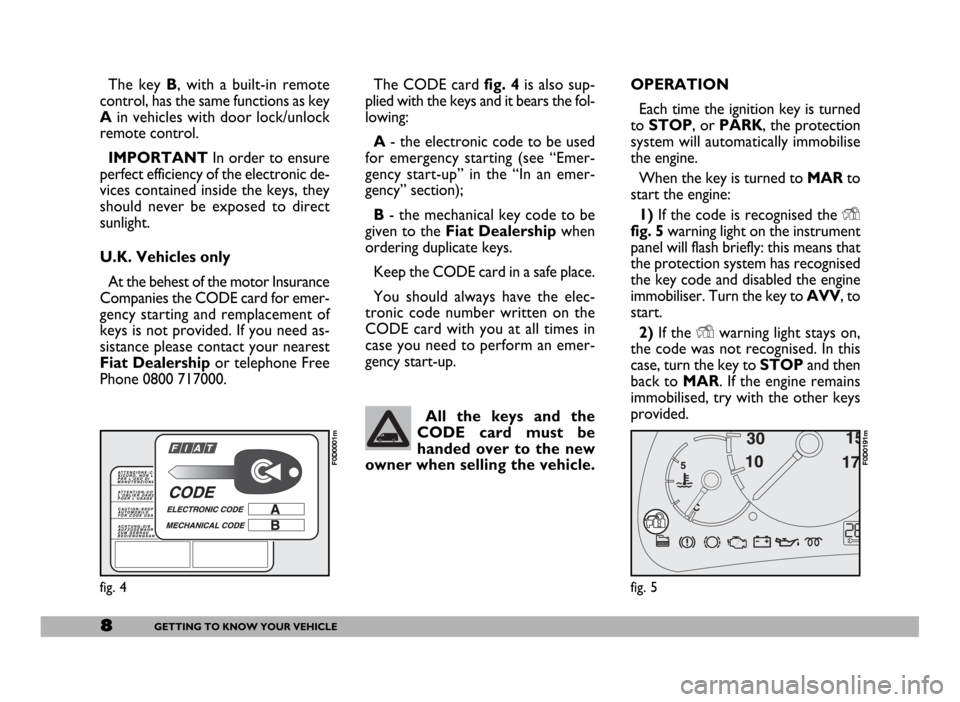
The CODE card fig. 4is also sup-
plied with the keys and it bears the fol-
lowing:
A- the electronic code to be used
for emergency starting (see “Emer-
gency start-up” in the “In an emer-
gency” section);
B- the mechanical key code to be
given to the Fiat Dealershipwhen
ordering duplicate keys.
Keep the CODE card in a safe place.
You should always have the elec-
tronic code number written on the
CODE card with you at all times in
case you need to perform an emer-
gency start-up. OPERATION
Each time the ignition key is turned
to STOP, or PARK, the protection
system will automatically immobilise
the engine.
When the key is turned to MARto
start the engine:
1)If the code is recognised the Y
fig. 5warning light on the instrument
panel will flash briefly: this means that
the protection system has recognised
the key code and disabled the engine
immobiliser. Turn the key to AVV, to
start.
2)If the Ywarning light stays on,
the code was not recognised. In this
case, turn the key to STOPand then
back to MAR. If the engine remains
immobilised, try with the other keys
provided.
fig. 5
F0D0191m
All the keys and the
CODE card must be
handed over to the new
owner when selling the vehicle.
8GETTING TO KNOW YOUR VEHICLE
The key B, with a built-in remote
control, has the same functions as key
Ain vehicles with door lock/unlock
remote control.
IMPORTANTIn order to ensure
perfect efficiency of the electronic de-
vices contained inside the keys, they
should never be exposed to direct
sunlight.
U.K. Vehicles only
At the behest of the motor Insurance
Companies the CODE card for emer-
gency starting and remplacement of
keys is not provided. If you need as-
sistance please contact your nearest
Fiat Dealershipor telephone Free
Phone 0800 717000.
fig. 4
F0D0001m
Page 29 of 258

28GETTING TO KNOW YOUR VEHICLE
IGNITION SWITCH
The key can be turned to four dif-
ferent positions fig. 26.
STOP:engine off, key can be re-
moved, steering column locked.
MAR:drive position. All electrical
devices can be used.
AVV:to start the engine.
PARK:engine off, parking lights on,
key can be removed, steering column
locked. To turn the key to PARK,
press button A.STEERING COLUMN LOCK
To engage the lock: remove the ig-
nition key at STOPor PARK, and
turn the steering wheel until it locks.
To release the lock: rock the steer-
ing wheel slightly as you turn the igni-
tion key to MAR.
fig. 26
F0D0052m
If the ignition switch has
been tampered with (e.g.
someone has tried to steal your ve-
hicle), get a Fiat Dealership to make
sure it is still functioning properly
before you start driving again.
WARNING
When you get out of the
vehicle, always remove the
ignition key. This will prevent any-
one from accidentally working the
controls. Remember to apply the
handbrake and, if the vehicle is
faced up on a steep slope engage
the first gear. If it is facing down,
engage the reverse gear. Never
leave children in the vehicle by
themselves.
WARNING
Never remove the ignition
key while the vehicle is
moving. The steering wheel will au-
tomatically lock as soon as you try
to turn it. This also applies when
the vehicle is being towed.
WARNING
It is absolutely forbidden to
carry out whatever after-
market operation involving steering
system or steering column modifi-
cations (e.g.: installation of anti-
theft Device) that could badly af-
fect performance and safety, cause
the lapse of warranty and also re-
sult in non-compliance of the car
with homologation requirements.
WARNING
Page 31 of 258
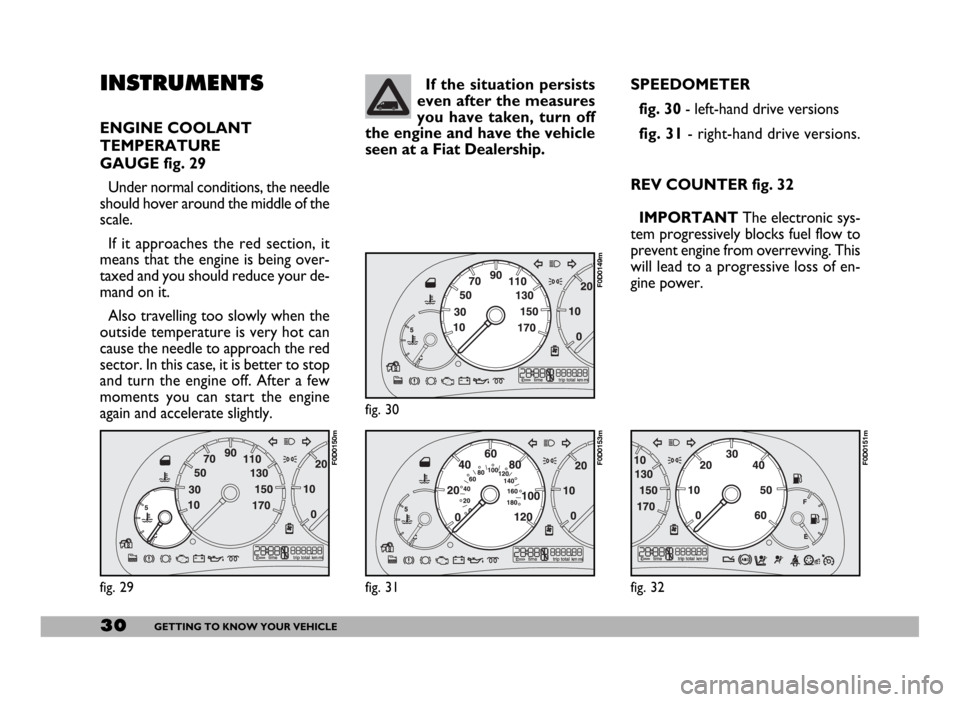
30GETTING TO KNOW YOUR VEHICLE
INSTRUMENTS
ENGINE COOLANT
TEMPERATURE
GAUGE fig. 29
Under normal conditions, the needle
should hover around the middle of the
scale.
If it approaches the red section, it
means that the engine is being over-
taxed and you should reduce your de-
mand on it.
Also travelling too slowly when the
outside temperature is very hot can
cause the needle to approach the red
sector. In this case, it is better to stop
and turn the engine off. After a few
moments you can start the engine
again and accelerate slightly.SPEEDOMETER
fig. 30- left-hand drive versions
fig. 31- right-hand drive versions.
REV COUNTER fig. 32
IMPORTANT The electronic sys-
tem progressively blocks fuel flow to
prevent engine from overrevving. This
will lead to a progressive loss of en-
gine power. If the situation persists
even after the measures
you have taken, turn off
the engine and have the vehicle
seen at a Fiat Dealership.
fig. 29
F0D0150m
fig. 30
F0D0149m
fig. 31
F0D0153m
fig. 32
F0D0151m
Page 34 of 258
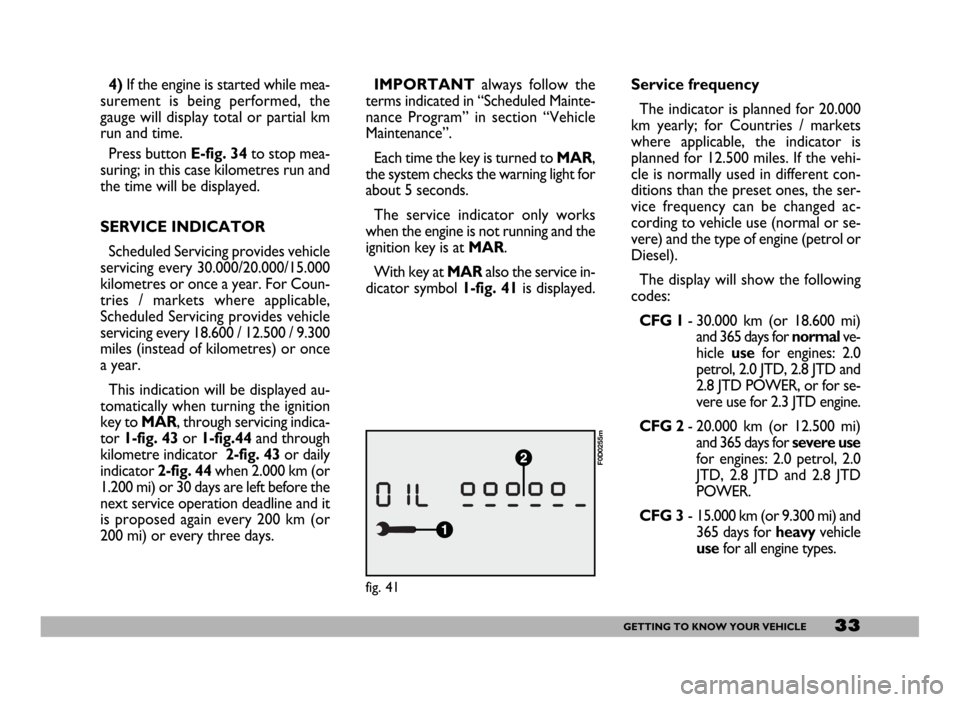
33GETTING TO KNOW YOUR VEHICLE
4)If the engine is started while mea-
surement is being performed, the
gauge will display total or partial km
run and time.
Press button E-fig. 34to stop mea-
suring; in this case kilometres run and
the time will be displayed.
SERVICE INDICATOR
Scheduled Servicing provides vehicle
servicing every 30.000/20.000/15.000
kilometres or once a year. For Coun-
tries / markets where applicable,
Scheduled Servicing provides vehicle
servicing every 18.600 / 12.500 / 9.300
miles (instead of kilometres) or once
a year.
This indication will be displayed au-
tomatically when turning the ignition
key to MAR, through servicing indica-
tor 1-fig. 43or 1-fig.44and through
kilometre indicator 2-fig. 43or daily
indicator 2-fig. 44when 2.000 km (or
1.200 mi) or 30 days are left before the
next service operation deadline and it
is proposed again every 200 km (or
200 mi) or every three days.
fig. 41
F0D0255m
IMPORTANTalways follow the
terms indicated in “Scheduled Mainte-
nance Program” in section “Vehicle
Maintenance”.
Each time the key is turned to MAR,
the system checks the warning light for
about 5 seconds.
The service indicator only works
when the engine is not running and the
ignition key is at MAR.
With key at MARalso the service in-
dicator symbol 1-fig. 41is displayed.Service frequency
The indicator is planned for 20.000
km yearly; for Countries / markets
where applicable, the indicator is
planned for 12.500 miles. If the vehi-
cle is normally used in different con-
ditions than the preset ones, the ser-
vice frequency can be changed ac-
cording to vehicle use (normal or se-
vere) and the type of engine (petrol or
Diesel).
The display will show the following
codes:
CFG 1- 30.000 km (or 18.600 mi)
and 365 days for normalve-
hicle usefor engines: 2.0
petrol, 2.0 JTD, 2.8 JTD and
2.8 JTD POWER, or for se-
vere use for 2.3 JTD engine.
CFG 2- 20.000 km (or 12.500 mi)
and 365 days for severe use
for engines: 2.0 petrol, 2.0
JTD, 2.8 JTD and 2.8 JTD
POWER.
CFG 3- 15.000 km (or 9.300 mi) and
365 days for heavyvehicle
usefor all engine types.
Page 37 of 258
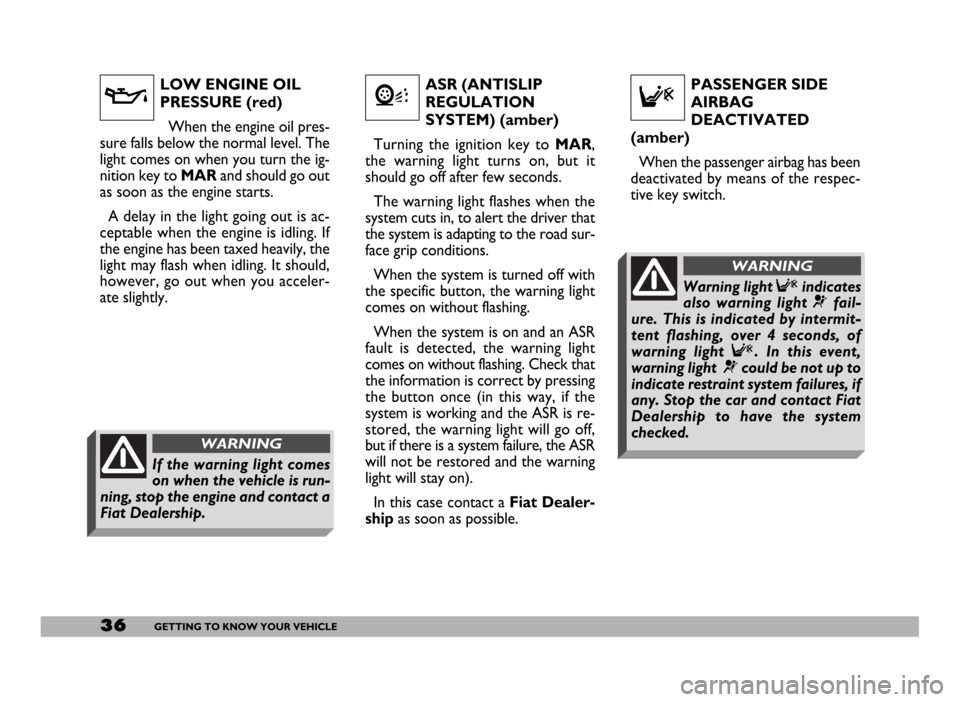
36GETTING TO KNOW YOUR VEHICLE
LOW ENGINE OIL
PRESSURE (red)
When the engine oil pres-
sure falls below the normal level. The
light comes on when you turn the ig-
nition key to MARand should go out
as soon as the engine starts.
A delay in the light going out is ac-
ceptable when the engine is idling. If
the engine has been taxed heavily, the
light may flash when idling. It should,
however, go out when you acceler-
ate slightly.vASR (ANTISLIP
REGULATION
SYSTEM) (amber)
Turning the ignition key to MAR,
the warning light turns on, but it
should go off after few seconds.
The warning light flashes when the
system cuts in, to alert the driver that
the system is adapting to the road sur-
face grip conditions.
When the system is turned off with
the specific button, the warning light
comes on without flashing.
When the system is on and an ASR
fault is detected, the warning light
comes on without flashing. Check that
the information is correct by pressing
the button once (in this way, if the
system is working and the ASR is re-
stored, the warning light will go off,
but if there is a system failure, the ASR
will not be restored and the warning
light will stay on).
In this case contact a Fiat Dealer-
shipas soon as possible.PASSENGER SIDE
AIRBAG
DEACTIVATED
(amber)
When the passenger airbag has been
deactivated by means of the respec-
tive key switch.
FV
If the warning light comes
on when the vehicle is run-
ning, stop the engine and contact a
Fiat Dealership.
WARNING
Warning light Findicates
also warning light ¬fail-
ure. This is indicated by intermit-
tent flashing, over 4 seconds, of
warning light F. In this event,
warning light ¬could be not up to
indicate restraint system failures, if
any. Stop the car and contact Fiat
Dealership to have the system
checked.
WARNING
Page 38 of 258
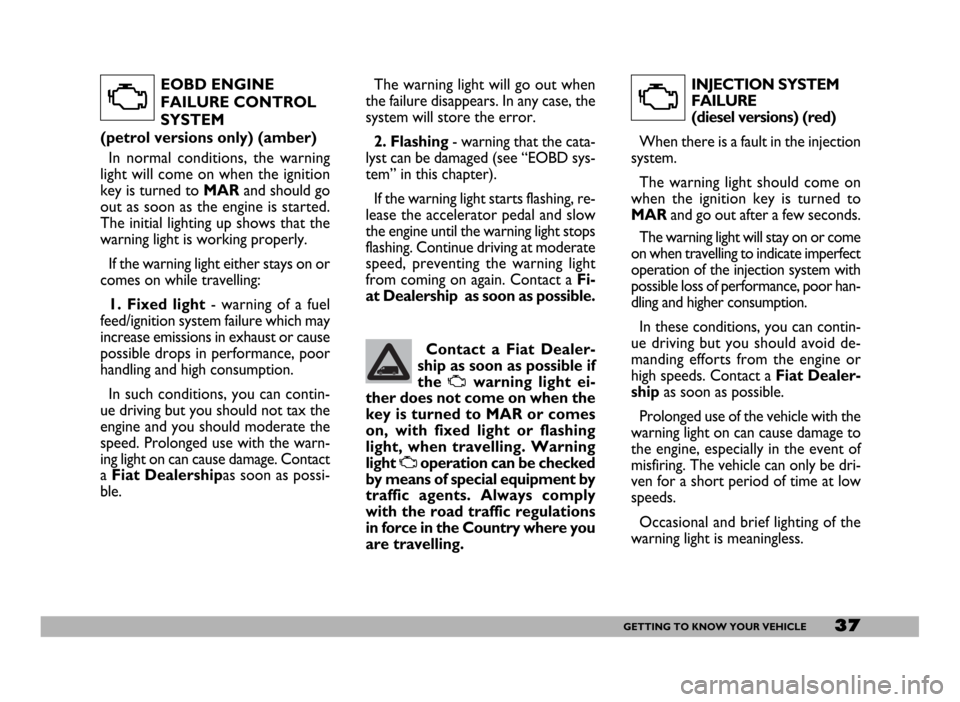
37GETTING TO KNOW YOUR VEHICLE
EOBD ENGINE
FAILURE CONTROL
SYSTEM
(petrol versions only) (amber)
In normal conditions, the warning
light will come on when the ignition
key is turned to MARand should go
out as soon as the engine is started.
The initial lighting up shows that the
warning light is working properly.
If the warning light either stays on or
comes on while travelling:
1. Fixed light- warning of a fuel
feed/ignition system failure which may
increase emissions in exhaust or cause
possible drops in performance, poor
handling and high consumption.
In such conditions, you can contin-
ue driving but you should not tax the
engine and you should moderate the
speed. Prolonged use with the warn-
ing light on can cause damage. Contact
a Fiat Dealershipas soon as possi-
ble. The warning light will go out when
the failure disappears. In any case, the
system will store the error.
2. Flashing- warning that the cata-
lyst can be damaged (see “EOBD sys-
tem” in this chapter).
If the warning light starts flashing, re-
lease the accelerator pedal and slow
the engine until the warning light stops
flashing. Continue driving at moderate
speed, preventing the warning light
from coming on again. Contact a Fi-
at Dealership as soon as possible.INJECTION SYSTEM
FAILURE
(diesel versions) (red)
When there is a fault in the injection
system.
The warning light should come on
when the ignition key is turned to
MARand go out after a few seconds.
The warning light will stay on or come
on when travelling to indicate imperfect
operation of the injection system with
possible loss of performance, poor han-
dling and higher consumption.
In these conditions, you can contin-
ue driving but you should avoid de-
manding efforts from the engine or
high speeds. Contact a Fiat Dealer-
shipas soon as possible.
Prolonged use of the vehicle with the
warning light on can cause damage to
the engine, especially in the event of
misfiring. The vehicle can only be dri-
ven for a short period of time at low
speeds.
Occasional and brief lighting of the
warning light is meaningless.
UU
Contact a Fiat Dealer-
ship as soon as possible if
the
Uwarning light ei-
ther does not come on when the
key is turned to MAR or comes
on, with fixed light or flashing
light, when travelling. Warning
light
Uoperation can be checked
by means of special equipment by
traffic agents. Always comply
with the road traffic regulations
in force in the Country where you
are travelling.
Page 39 of 258
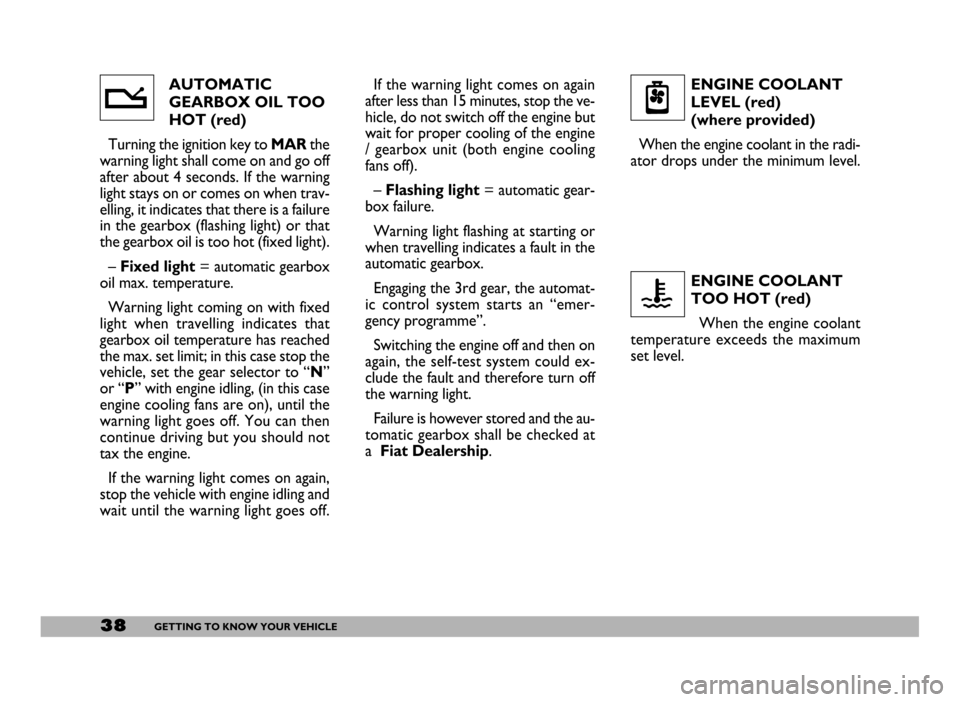
38GETTING TO KNOW YOUR VEHICLE
ENGINE COOLANT
LEVEL (red)
(where provided)
When the engine coolant in the radi-
ator drops under the minimum level.
n
AUTOMATIC
GEARBOX OIL TOO
HOT (red)
Turning the ignition key to MARthe
warning light shall come on and go off
after about 4 seconds. If the warning
light stays on or comes on when trav-
elling, it indicates that there is a failure
in the gearbox (flashing light) or that
the gearbox oil is too hot (fixed light).
– Fixed light= automatic gearbox
oil max. temperature.
Warning light coming on with fixed
light when travelling indicates that
gearbox oil temperature has reached
the max. set limit; in this case stop the
vehicle, set the gear selector to “N”
or “P” with engine idling, (in this case
engine cooling fans are on), until the
warning light goes off. You can then
continue driving but you should not
tax the engine.
If the warning light comes on again,
stop the vehicle with engine idling and
wait until the warning light goes off.If the warning light comes on again
after less than 15 minutes, stop the ve-
hicle, do not switch off the engine but
wait for proper cooling of the engine
/ gearbox unit (both engine cooling
fans off).
– Flashing light= automatic gear-
box failure.
Warning light flashing at starting or
when travelling indicates a fault in the
automatic gearbox.
Engaging the 3rd gear, the automat-
ic control system starts an “emer-
gency programme”.
Switching the engine off and then on
again, the self-test system could ex-
clude the fault and therefore turn off
the warning light.
Failure is however stored and the au-
tomatic gearbox shall be checked at
a Fiat Dealership.ENGINE COOLANT
TOO HOT (red)
When the engine coolant
temperature exceeds the maximum
set level.
u
t
Page 61 of 258
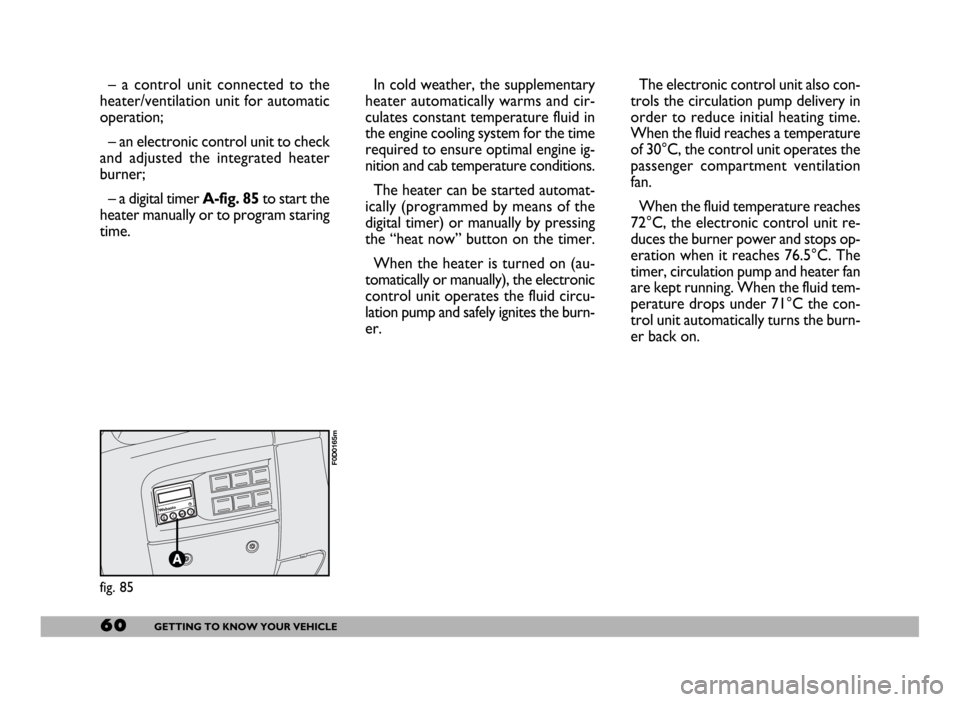
60GETTING TO KNOW YOUR VEHICLE
– a control unit connected to the
heater/ventilation unit for automatic
operation;
– an electronic control unit to check
and adjusted the integrated heater
burner;
– a digital timer A-fig. 85to start the
heater manually or to program staring
time.In cold weather, the supplementary
heater automatically warms and cir-
culates constant temperature fluid in
the engine cooling system for the time
required to ensure optimal engine ig-
nition and cab temperature conditions.
The heater can be started automat-
ically (programmed by means of the
digital timer) or manually by pressing
the “heat now” button on the timer.
When the heater is turned on (au-
tomatically or manually), the electronic
control unit operates the fluid circu-
lation pump and safely ignites the burn-
er.The electronic control unit also con-
trols the circulation pump delivery in
order to reduce initial heating time.
When the fluid reaches a temperature
of 30°C, the control unit operates the
passenger compartment ventilation
fan.
When the fluid temperature reaches
72°C, the electronic control unit re-
duces the burner power and stops op-
eration when it reaches 76.5°C. The
timer, circulation pump and heater fan
are kept running. When the fluid tem-
perature drops under 71°C the con-
trol unit automatically turns the burn-
er back on.
fig. 85
F0D0165m
Page 74 of 258
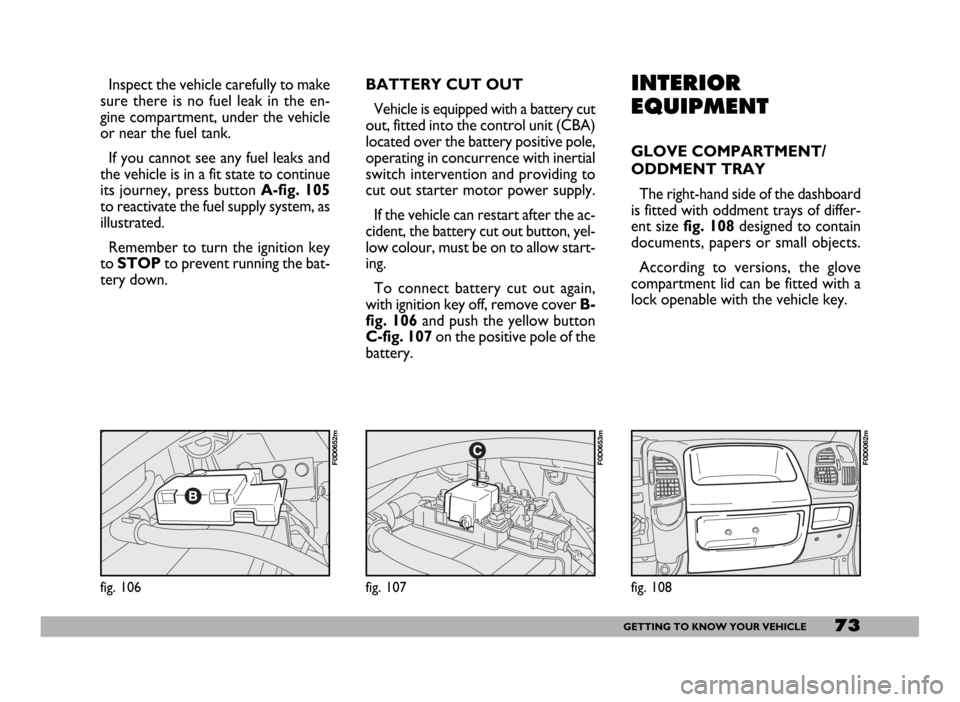
73GETTING TO KNOW YOUR VEHICLE
Inspect the vehicle carefully to make
sure there is no fuel leak in the en-
gine compartment, under the vehicle
or near the fuel tank.
If you cannot see any fuel leaks and
the vehicle is in a fit state to continue
its journey, press button A-fig. 105
to reactivate the fuel supply system, as
illustrated.
Remember to turn the ignition key
to STOPto prevent running the bat-
tery down.INTERIOR
EQUIPMENT
GLOVE COMPARTMENT/
ODDMENT TRAY
The right-hand side of the dashboard
is fitted with oddment trays of differ-
ent sizefig. 108designed to contain
documents, papers or small objects.
According to versions, the glove
compartment lid can be fitted with a
lock openable with the vehicle key.
fig. 108
F0D0062m
fig. 106
F0D0652m
fig. 107
F0D0653m
BATTERY CUT OUT
Vehicle is equipped with a battery cut
out, fitted into the control unit (CBA)
located over the battery positive pole,
operating in concurrence with inertial
switch intervention and providing to
cut out starter motor power supply.
If the vehicle can restart after the ac-
cident, the battery cut out button, yel-
low colour, must be on to allow start-
ing.
To connect battery cut out again,
with ignition key off, remove cover B-
fig. 106 and push the yellow button
C-fig. 107 on the positive pole of the
battery.
Page 84 of 258

83GETTING TO KNOW YOUR VEHICLE
CENTRAL DOOR LOCKING
IMPORTANTCentral door locking
is active on all doors if front doors (cab
doors) are used for opening/closing.
When operating one of the rear or
side door lock, only that door will be
locked/unlocked.
From the outside
When the doors are closed, insert
and turn the key in the lock of one of
the driver’s cab doors.
From the inside
When the doors are closed, press
(to lock) or lift (to unlock) one of the
driver’s cab door safety sill buttons.
IMPORTANT If one of the cab
doors is not shut properly or there is
a failure in the system, the central
locking feature will not work and, af-
ter some attempts, the device will stop
working for about 2 minutes. In these
two minutes, the doors can be locked
or unlocked manually without the
electrical system coming into play.After the two minutes, the control
unit is ready to receive commands
once more. If the reason for the mal-
functioning has been removed, the de-
vice will start to work properly again.
If not, it will cut once more.
FRONT DOOR WINDOW
REGULATORS
Manual control
Use the window winderA-fig 130to
open or close the door window.
Electric control
There are two buttons fig. 131to
control the front door electrical win-
dows located in the inside handle of
the driver’s door. They work when
the key is turned to MAR:A- to open/close left window
B- to open/close right window.
The door handle on the passenger
side has a button C-fig. 132to con-
trol that particular window.
fig. 130
F0D01870m
fig. 131
F0D0120m
fig. 132
F0D0121m